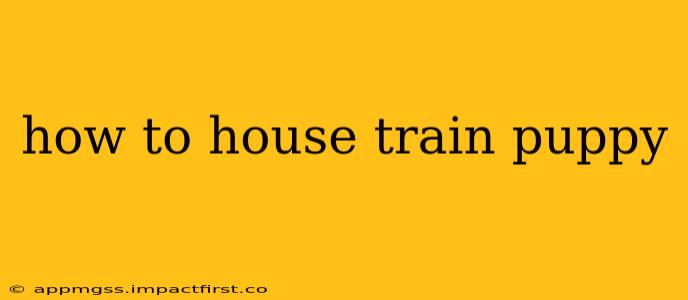Bringing home a new puppy is incredibly exciting, but the reality of house training can quickly become overwhelming. Consistency, patience, and understanding are key to success. This comprehensive guide will walk you through the process, addressing common questions and concerns along the way. We'll delve into effective techniques, address potential problems, and help you navigate the journey to a reliably house-trained pup.
What is the best way to house train a puppy?
The most effective house training method combines positive reinforcement with consistent routines and proactive management. This means rewarding your puppy immediately for eliminating outside and preventing accidents through careful supervision and frequent potty breaks. Avoid punishment, which can create fear and anxiety, hindering the training process. Positive reinforcement, such as treats, praise, and playful interactions, makes the experience positive and encourages your puppy to repeat the desired behavior.
How often should I take my puppy outside to potty?
This depends on your puppy's age and size. As a general rule:
- Puppies under 4 months: Need to go out every 1-2 hours, immediately after waking up, after playing, and after eating or drinking.
- Puppies 4-6 months: Can usually hold it for 3-4 hours, but still require frequent potty breaks.
- Older puppies: Can gradually extend the time between potty breaks.
Always err on the side of caution and take your puppy out more frequently than you think is necessary, especially in the beginning.
How long does it take to house train a puppy?
The house training timeline varies significantly depending on the breed, age, personality, and consistency of your training. Some puppies might master house training within a few weeks, while others may take several months. Be patient and celebrate small victories along the way. Consistency and positive reinforcement are crucial to success.
What should I do if my puppy has an accident?
Accidents happen! The key is to react calmly. Avoid yelling or punishing your puppy, as this will only create fear and anxiety. Clean the accident thoroughly using an enzymatic cleaner to eliminate the odor, which can attract your puppy to the same spot again. Don't rub your puppy's nose in the mess; instead, focus on preventing future accidents through more frequent potty breaks and careful supervision.
What are the signs my puppy needs to go potty?
Recognizing your puppy's potty cues is crucial for preventing accidents. These cues can include:
- Restlessness: Pacing, whining, scratching at the door.
- Sniffing: Intense sniffing around the house, especially in corners.
- Squatting: A clear sign that your puppy is about to eliminate.
- Sudden changes in behavior: Becoming unusually quiet or going to a particular spot repeatedly.
Pay close attention to these signs, and take your puppy outside immediately when you notice them.
My puppy is still having accidents at night. What can I do?
Nighttime accidents are common, especially with younger puppies. To minimize accidents:
- Restrict access to water a few hours before bedtime: This will reduce the need for nighttime potty breaks.
- Create a designated sleep area: This could be a crate or a dog bed in a quiet area.
- Take your puppy out for a final potty break right before bed: This will give them the opportunity to eliminate before settling down for the night.
- Consider using a puppy pad: If absolutely necessary, provide a designated area for elimination during the night. However, it's best to transition them to outdoor elimination as quickly as possible.
Consistency and patience are vital for nighttime house training.
What if my puppy is not responding to house training?
If you're struggling with house training, it's essential to rule out any underlying medical issues. Consult your veterinarian to eliminate any potential health problems affecting your puppy's ability to control their bladder or bowels. Additionally, seek guidance from a certified professional dog trainer who can help you identify and address any issues in your training approach. Remember, every puppy is different, and what works for one may not work for another.
By employing these strategies, paying close attention to your puppy's cues, and remaining patient and consistent, you'll successfully navigate the house training journey and enjoy a happy and well-behaved canine companion.
